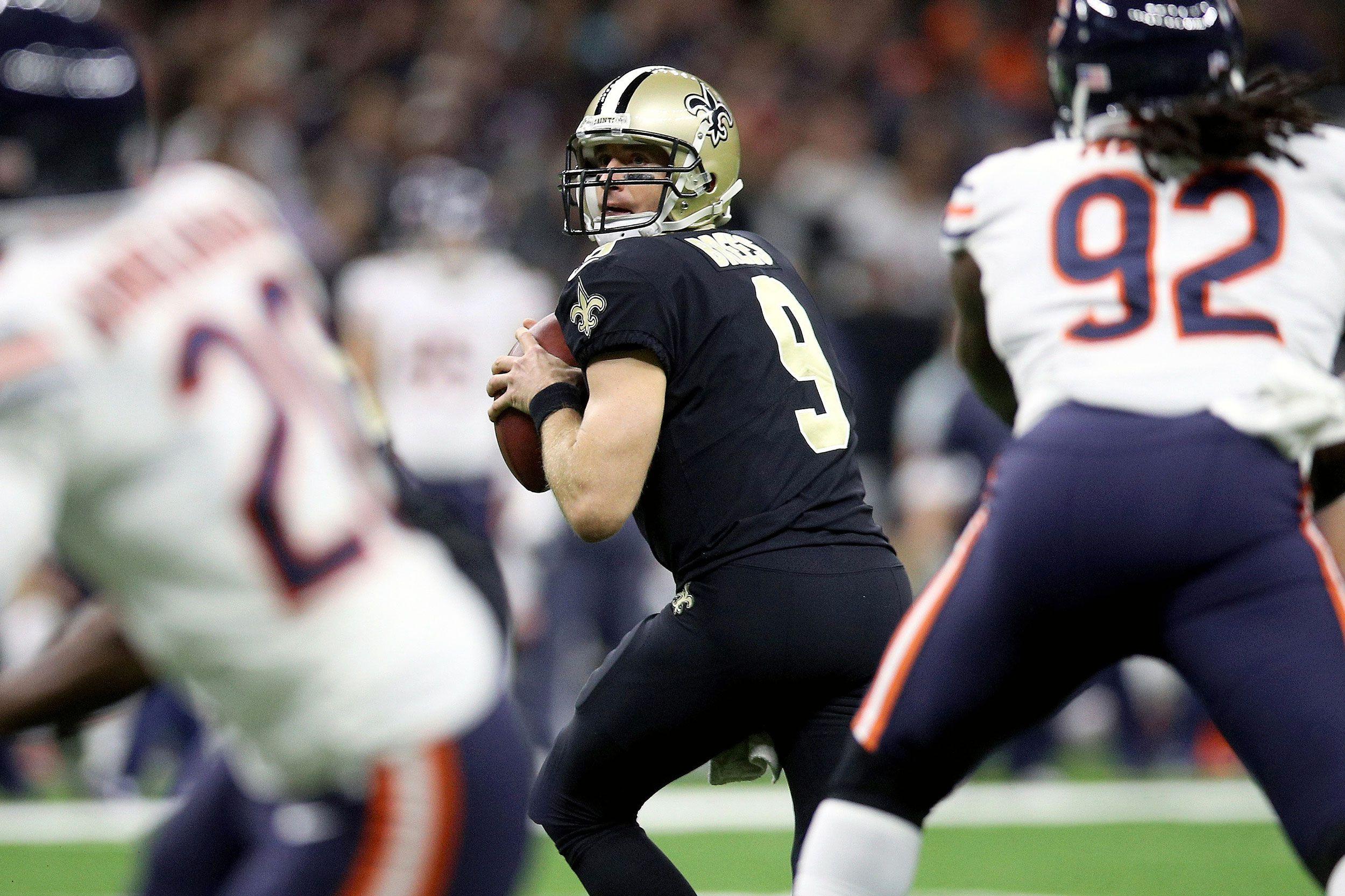
I made the seemingly smart decision to draft Drew Brees in my fantasy football league. I’m guessing somewhere between 1 in 10 and 1 in 12 football-watching Americans did, too. Brees has five of the top eight passing yardage seasons of all time. He’s thrown 40 or more touchdown passes in a season twice, accounting for two of the 10 times that’s ever happened in the pros. Brees has been one of the top-10 fantasy QBs in standard scoring leagues every year since 2004. Seven times, he’s ranked in the top three.
Entering Week 11 of this season, though, Brees sits 11th among fantasy quarterbacks. He’s hit 300 passing yards only twice; he’s thrown for zero touchdowns in two separate games, and just one in two others. He’s on pace to finish with 4,263 passing yards and 23 touchdowns, both totals that’d be the lowest of his 12-year Saints career. What’s wrong with Brees? Is age catching up to the 38-year-old? Does he need to adopt the TB12 Method? Are the Saints doomed?
No, it’s quite the opposite. Brees’s statistical decline is a sign that that rest of the franchise has finally caught up with its star player. For the first time in a long time, the Saints don’t need an all-time great quarterback to play like one.
If throwing a football were like pitching a baseball, Brees probably would’ve needed Tommy John surgery a long time ago. He has five of the top 12 NFL seasons in terms of passing attempts, and he’s third on the all-time list in that category (9,058), about half of a regular Brees season away from passing Peyton Manning (9,380) for second, and perhaps two years shy of passing Brett Favre (10,169) for first.
However, last Sunday, Brees had what must have felt like the most relaxing day of his entire career. The Saints ran the ball 48 times for 298 yards in a 47–10 rout of the Bills, a win that was New Orleans’s seventh in a row and pushed its record to 7–2. At one point, the Saints rattled off a stretch of 24 straight offensive run plays. Brees attempted just 25 passes — a lot for some quarterbacks, but not by Brees’s standards. In 183 games with New Orleans, this was the fourth-fewest passes he’d ever thrown, and one of the three other was a Week 17 contest in which Brees was pulled early to avoid risking injury. He didn’t throw any touchdown passes against Buffalo, marking just the just the fifth time in his Saints career that the team has won a game in which that’s happened — and the second time it’s occurred within the past month.
The Saints have fielded one of the worst defenses in the NFL for large swaths of Brees’s tenure. They finished in the bottom five in points allowed in four of the last five seasons; they were dead last in 2015. In 2012, they ranked last in the league in total yards allowed. Even when New Orleans won the Super Bowl after the 2009 season, it was in the bottom half of most defensive categories — except for turnovers, a stat in which it was second.
And while the offense has been perennially good with Brees under center, he has rarely had much help from the ground game. Since 2006, Brees’s first season with the club, the Saints have had just two 1,000-yard rushers: Mark Ingram last fall (1,043) and Deuce McAllister in 2006 (1,057). The team has averaged fewer than 4 yards per rush in four seasons during Brees’s Saints tenure; three times, it finished in the bottom five in the league in rushing yardage. If running backs did contribute, it was generally by catching passes out of the backfield.

In 2017, both trends have turned. This defense is close to the best that New Orleans has ever had, allowing just 18.3 points per game, the fifth lowest in the league. Rookie Marshon Lattimore has emerged as perhaps the best cornerback in the NFL — he’s the top-rated player at the position, per grades from Pro Football Focus — and defensive end Cam Jordan is enjoying one of the best years of his career. On the other side of the ball, the Saints lead the NFL in rushing touchdowns (14), with Mark Ingram tallying a league-best seven scores and rookie Alvin Kamara averaging 6.5 yards per carry, a clip that leads the league by more than half a yard per carry.
With a decent defense, Brees no longer spends Sunday afternoons chasing points by chucking the ball 40-plus times. And when New Orleans goes up big, it has a run game it can rely on to ice games. In a 52–38 win over the Lions in Week 6 — the Saints’ second-highest scoring output since Brees’s arrival — he attempted just 30 passes and accounted for two of the team’s seven touchdowns; in a 20–12 victory over the Bears in Week 8, he passed only 28 times as running backs notched both of the team’s offensive scores; in last week’s blowout of Buffalo, he virtually didn’t need to throw at all.
Don’t let the lack of production fool you into believing that Brees is performing badly. He’s averaging 8.0 yards per attempt, the third-best mark of his Saints career. His completion percentage is a career-high 71.7, and his interception rate is a career-low 1.3. He isn’t throwing as many touchdowns as he traditionally has, and he isn’t making as many big plays as we’re accustomed to — but that’s largely because they isn’t needed.
In the past, the Saints have occasionally had a strong defense, like when they ranked fourth in points allowed in 2013. And they’ve occasionally had a decent running game, like when they finished in the top 10 in rushing touchdowns and yards per attempt in 2014. Until now, though, they’ve never had both at the same time. Brees may seem like he’s on the decline given our obsession with fantasy football and the way that our perception is shaped by how prolifically skill-position players accumulate counting stats. In reality, he just finally has help — great news for both him and the Saints.
It’s also terrible news for those of us who drafted Brees in fantasy football. Don’t the Saints realize how embarrassing it is for sportswriters to finish, like, seventh in fantasy sports leagues with people who have actual jobs?